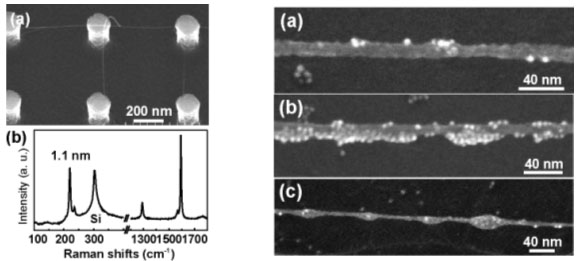using DNA and Gold Nanoparticles
Goo-Hwan Jeong, Satoru Suzuki and Yoshihiro Kobayashi
Material Science Laboratory
Due to the outstanding physical, chemical and electrical
properties of carbon nanotubes (CNT), a number of applications in various
fields are expected. Especially, extensive researches related with CNT-functionalization
using foreign atom or molecules have been performed to control electronic
property of CNT because diameter- or chirality-controlled growth has not been
realized yet, which is determining factor of electronic property. Here, we
introduce our CNT-functionalization study for the application of CNT-based
nanoelectronics or biosensor. DNA and Au nanoparticles (NP) are selected among
various materials to functionalize CNT [1] owing to their specific assembling
and strong coupling properties.
Ferritin covered with protein shell and contains Fe clusters in its 6-nm
diameter inner space was used to synthesize diameter-controlled single-walled
carbon nanotubes (SWNTs). A Co-ferritin, Fe is replaced by Co, was also used.
By controlled methane CVD experiments at 900oC, suspended SWNTs are successfully
synthesized on Si or SiO2 pillar-structured substrates using not only ferritin
but also Co-ferritin, which is the first report [2]. A scanning electron microscope
(SEM) image [Fig. 1(a)] and Raman spectrum [Fig. 1(b)] of the suspended SWNTs
grown using Co-ferritin catalyst are presented.
SWNTs-functionalization was performed by covalent coupling between carboxyl
and amine groups produced by acid and aminopropyltriethoxysilane (APTES) treatment,
respectively. DNA/Au hybrids were made by simple mixing of thiolated-DNA and
Au NP (5nm diameter). Finally, SWNTs are modified by Au NP or DNA/Au hybrids.
Figure 2 shows SEM images obtained from SWNTs/Au [Fig. 2(a) and (b)] and
SWNTs/DNA/Au hybrids [Fig. 2(c)]. The density of Au NP attached along the
suspended SWNTs was controlled by changing treatment time and Au-colloid concentration.
In addition, the change of Raman spectra was also observed from the SWNTs/DNA/Au
hybrid [3], which implies the different electronic or optical properties are
expected. These results show functionalized CNT can be developed to electronic
and optical applications.
[1] M. Zheng et al., Science 302 (2003) 1545-1548.
[2] G.-H. Jeong et al., J. Am. Chem. Soc., submitted 2005.
[3] G.-H. Jeong et al., MRS 2005 Spring Meeting, San Francisco, March 2005.
 |
||||
Fig. 1.
|
Suspended SWNTs from
Co-ferritin.(a) SEM image and (b) Raman result. |
Fig. 2. | SEM images of CNT/Au hybrids [(a),(b)] and CNT/DNA/Au hybrid (c). | |